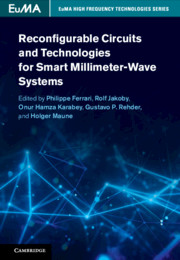Book contents
- Reconfigurable Circuits and Technologies for Smart Millimeter-Wave Systems
- EuMA High Frequency Technologies Series
- Reconfigurable Circuits and Technologies for Smart Millimeter-Wave Systems
- Copyright page
- Contents
- Contributors
- Preface
- Abbreviations
- 1 Introduction and Motivation
- 2 Reconfigurable Devices and Smart Antennas
- 3 CMOS and BiCMOS Technologies
- 4 RF MEMS Technology
- 5 Microwave Liquid Crystal Technology
- Book part
- Index
- References
3 - CMOS and BiCMOS Technologies
Published online by Cambridge University Press: 20 May 2022
- Reconfigurable Circuits and Technologies for Smart Millimeter-Wave Systems
- EuMA High Frequency Technologies Series
- Reconfigurable Circuits and Technologies for Smart Millimeter-Wave Systems
- Copyright page
- Contents
- Contributors
- Preface
- Abbreviations
- 1 Introduction and Motivation
- 2 Reconfigurable Devices and Smart Antennas
- 3 CMOS and BiCMOS Technologies
- 4 RF MEMS Technology
- 5 Microwave Liquid Crystal Technology
- Book part
- Index
- References
Summary
This chapter describes tunable circuits in CMOS and BiCMOS technologies. First, active and passive basic components are briefly described: MOS and bipolar transistors, and passive components like MOM capacitors, and transmission lines. Slow-wave transmission lines are described and compared to their microstrip lines counterparts, in terms of electrical performance and footprint. Next, tunable components are introduced,varactors and switches, anddigital tunable capacitors. Then, tunable transmission lines are described. Some examples of tunable inductances are also highlighted. Finally, two families of tunable circuits are addressed, phase shifter and VCOs, respectively. Both circuits are used in many systems for beam-forming/steering concerning phase shifters, and transceivers concerning VCOs, respectively. Many design examples are given. Topologies based on the use of lumped components (varactors and inductances) are compared to those based on distributed components (tunable transmission lines). In the middle, hybrid approaches mixing lumped and distributed components can lead to very efficient solutions, both in terms of electrical performance and footprint.
Keywords
- Type
- Chapter
- Information
- Publisher: Cambridge University PressPrint publication year: 2022



